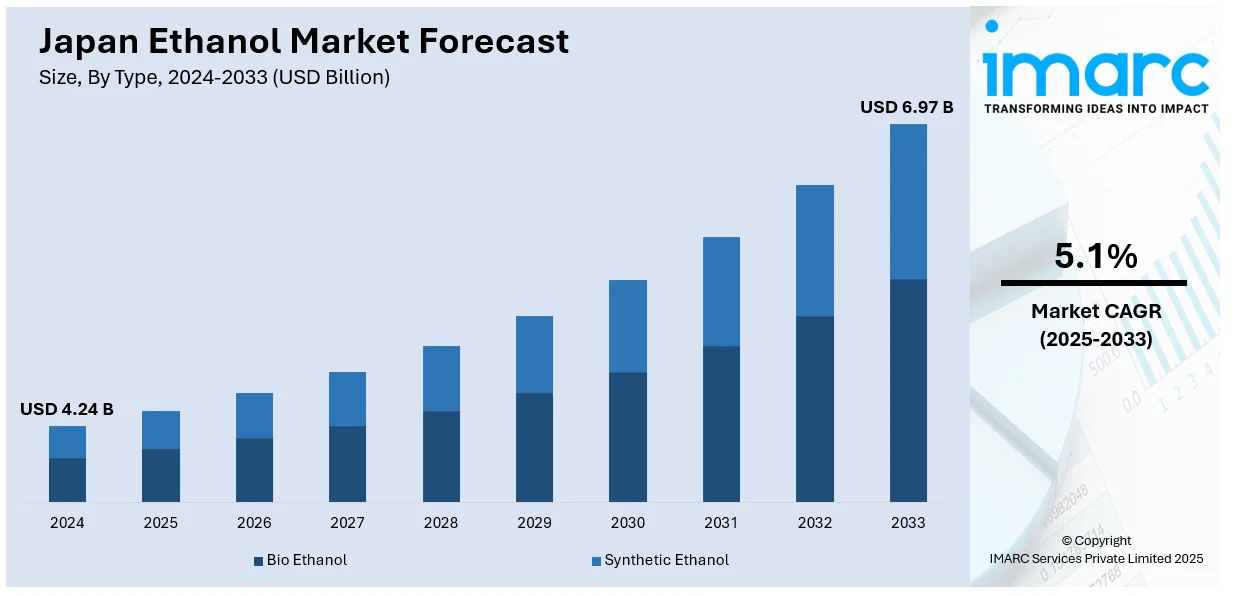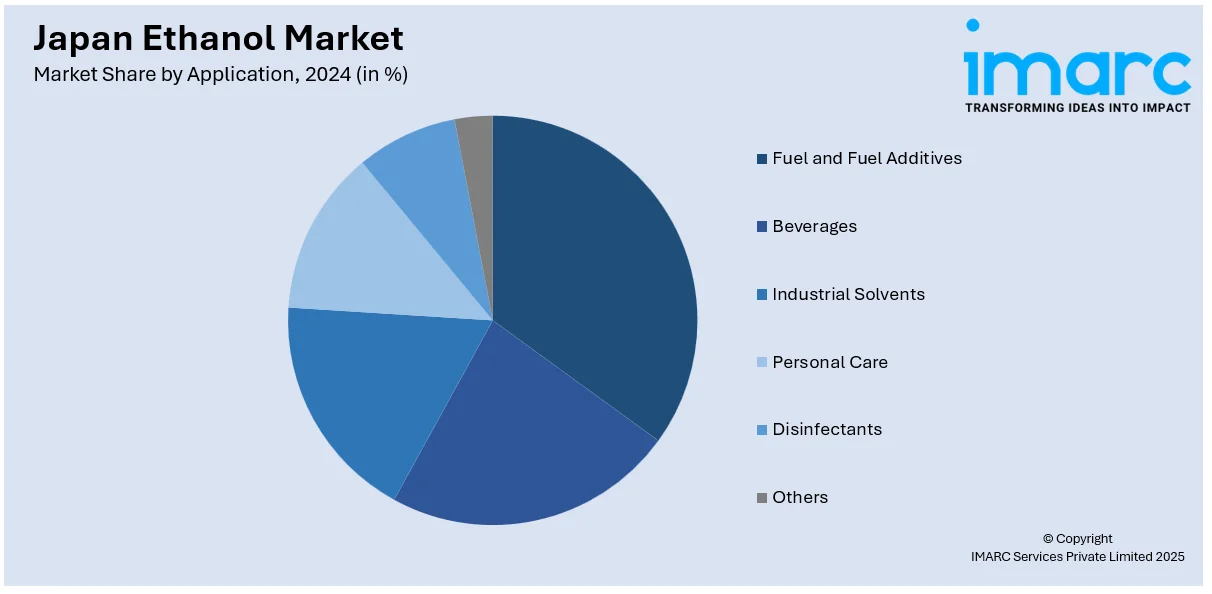
Japan Ethanol Market Size, Share, Trends and Forecast by Type, Raw Material, Purity, Application, and Region, 2025-2033
Japan Ethanol Market Overview:
The Japan ethanol market size reached USD 4.24 Billion in 2024. Looking forward, IMARC Group expects the market to reach USD 6.97 Billion by 2033, exhibiting a growth rate (CAGR) of 5.1% during 2025-2033. Government policies promoting renewable energy, consumer demand for eco-friendly products, and diversification of energy sources are some of the factors contributing to Japan ethanol market share. Technological advancements in bioethanol production and support for domestic manufacturing further stimulate market growth.
|
Report Attribute
|
Key Statistics
|
|---|---|
|
Base Year
|
2024 |
|
Forecast Years
|
2025-2033
|
|
Historical Years
|
2019-2024
|
| Market Size in 2024 | USD 4.24 Billion |
| Market Forecast in 2033 | USD 6.97 Billion |
| Market Growth Rate 2025-2033 | 5.1% |
Japan Ethanol Market Trends:
Shift toward Bio-Based Butadiene Production
Japan is witnessing a move toward bio-derived chemical inputs, particularly with efforts to manufacture butadiene using ethanol sourced from plants. A new facility is planned to focus on this production pathway, supporting the broader push for eco-friendly synthetic rubber. The initiative is backed by government funding to foster carbon-neutral technologies and aligns with national goals of reducing dependence on fossil feedstocks. The plant will produce experimental rubber for evaluation in tire applications, indicating a significant step toward integrating circular economy practices in the chemical and automotive sectors. This signals growing investment in low-emission alternatives across industrial value chains, emphasizing renewable feedstock utilization in Japan’s ethanol-linked downstream market. These factors are intensifying the Japan ethanol market growth. For example, in February 2025, Zeon Corporation and Yokohama Rubber announced plans to launch a facility at Zeon's Tokuyama Plant by 2026 to produce butadiene from plant-based ethanol. This project, backed by NEDO's Green Innovation Fund, aims to develop sustainable rubber materials. Zeon will create prototype rubber, while Yokohama will test tires made from it, contributing to Japan's push for carbon neutrality and a circular economy.

Integration of Bioethanol in Decentralized Power Systems
Japan is advancing the use of ethanol in clean energy applications through pilot initiatives that convert bioethanol into electricity using solid oxide fuel cell (SOFC) technology. A recently launched trial employs sorghum-based ethanol to generate high-efficiency power for industrial use, aligning with national decarbonization goals. The renewable fuel is produced domestically, offering a closed carbon loop by reabsorbing emissions during plant growth. This approach not only supports local energy resilience but also emphasizes the role of ethanol as a viable, low-impact alternative to conventional fuels. It marks a broader movement toward integrating bioethanol into stationary energy infrastructure, reinforcing its potential beyond transportation and positioning it as a key contributor in Japan’s clean energy mix. For instance, in March 2024, Nissan launched trials of a stationary power system at its Tochigi Plant using bioethanol made from sorghum. The system, based on solid oxide fuel cell (SOFC) tech, uses ethanol to generate high-efficiency electricity and supports Japan's carbon-neutral goals. Sorghum bioethanol, developed with Binex Inc., ensures sustainability by absorbing emitted CO₂ during plant growth, promoting a low-impact renewable fuel cycle within Japan’s ethanol and clean energy sectors.
Japan Ethanol Market Segmentation:
IMARC Group provides an analysis of the key trends in each segment of the market, along with forecasts at the country and regional levels for 2025-2033. Our report has categorized the market based on type, raw material, purity, and application.
Type Insights:
- Bio Ethanol
- Synthetic Ethanol
The report has provided a detailed breakup and analysis of the market based on the type. This includes bio ethanol and synthetic ethanol.
Raw Material Insights:
- Sugar and Molasses
- Cassava
- Rice
- Algal Biomass
- Ethylene
- Lignocellulosic Biomass
A detailed breakup and analysis of the market based on the raw material have also been provided in the report. This includes sugar and molasses, cassava, rice, algal biomass, ethylene, and lignocellulosic biomass.
Purity Insights:
- Denatured
- Undenatured
The report has provided a detailed breakup and analysis of the market based on the purity. This includes denatured and undenatured.
Application Insights:

- Fuel and Fuel Additives
- Beverages
- Industrial Solvents
- Personal Care
- Disinfectants
- Others
A detailed breakup and analysis of the market based on the application have also been provided in the report. This includes fuel and fuel additives, beverages, industrial solvents, personal care, disinfectants, and others.
Regional Insights:
- Kanto Region
- Kansai/Kinki Region
- Central/Chubu Region
- Kyushu-Okinawa Region
- Tohoku Region
- Chugoku Region
- Hokkaido Region
- Shikoku Region
The report has also provided a comprehensive analysis of all the major regional markets, which include Kanto region, Kansai/Kinki region, Central/Chubu region, Kyushu-Okinawa region, Tohoku region, Chugoku region, Hokkaido region, and Shikoku region.
Competitive Landscape:
The market research report has also provided a comprehensive analysis of the competitive landscape. Competitive analysis such as market structure, key player positioning, top winning strategies, competitive dashboard, and company evaluation quadrant has been covered in the report. Also, detailed profiles of all major companies have been provided.
Japan Ethanol Market News:
- In February 2025, Nippon Paper Industries, Sumitomo Corporation, and Green Earth Institute announced plans to establish Morisora Bio Refinery LLC, a joint venture focused on producing bioethanol and biochemicals from woody biomass. A semi-commercial plant would be constructed at Nippon Paper's Iwanuma Mill in Miyagi Prefecture, utilizing sustainable forest resources from the Tohoku region.
Japan Ethanol Market Report Coverage:
| Report Features | Details |
|---|---|
| Base Year of the Analysis | 2024 |
| Historical Period | 2019-2024 |
| Forecast Period | 2025-2033 |
| Units | Billion USD |
| Scope of the Report |
Exploration of Historical Trends and Market Outlook, Industry Catalysts and Challenges, Segment-Wise Historical and Future Market Assessment:
|
| Types Covered | Bio Ethanol, Synthetic Ethanol |
| Raw Materials Covered | Sugar and Molasses, Cassava, Rice, Algal Biomass, Ethylene, Lignocellulosic Biomass |
| Purities Covered | Denatured, Undenatured |
| Applications Covered | Fuel and Fuel Additives, Beverages, Industrial Solvents, Personal Care, Disinfectants, Others |
| Regions Covered | Kanto Region, Kansai/Kinki Region, Central/Chubu Region, Kyushu-Okinawa Region, Tohoku Region, Chugoku Region, Hokkaido Region, Shikoku Region |
| Customization Scope | 10% Free Customization |
| Post-Sale Analyst Support | 10-12 Weeks |
| Delivery Format | PDF and Excel through Email (We can also provide the editable version of the report in PPT/Word format on special request) |
Key Questions Answered in This Report:
- How has the Japan ethanol market performed so far and how will it perform in the coming years?
- What is the breakup of the Japan ethanol market on the basis of type?
- What is the breakup of the Japan ethanol market on the basis of raw material?
- What is the breakup of the Japan ethanol market on the basis of purity?
- What is the breakup of the Japan ethanol market on the basis of application?
- What is the breakup of the Japan ethanol market on the basis of region?
- What are the various stages in the value chain of the Japan ethanol market?
- What are the key driving factors and challenges in the Japan ethanol market?
- What is the structure of the Japan ethanol market and who are the key players?
- What is the degree of competition in the Japan ethanol market?
Key Benefits for Stakeholders:
- IMARC’s industry report offers a comprehensive quantitative analysis of various market segments, historical and current market trends, market forecasts, and dynamics of the Japan ethanol market from 2019-2033.
- The research report provides the latest information on the market drivers, challenges, and opportunities in the Japan ethanol market.
- Porter's five forces analysis assist stakeholders in assessing the impact of new entrants, competitive rivalry, supplier power, buyer power, and the threat of substitution. It helps stakeholders to analyze the level of competition within the Japan ethanol industry and its attractiveness.
- Competitive landscape allows stakeholders to understand their competitive environment and provides an insight into the current positions of key players in the market.
Need more help?
- Speak to our experienced analysts for insights on the current market scenarios.
- Include additional segments and countries to customize the report as per your requirement.
- Gain an unparalleled competitive advantage in your domain by understanding how to utilize the report and positively impacting your operations and revenue.
- For further assistance, please connect with our analysts.
 Request Customization
Request Customization
 Speak to an Analyst
Speak to an Analyst
 Request Brochure
Request Brochure
 Inquire Before Buying
Inquire Before Buying




.webp)




.webp)












